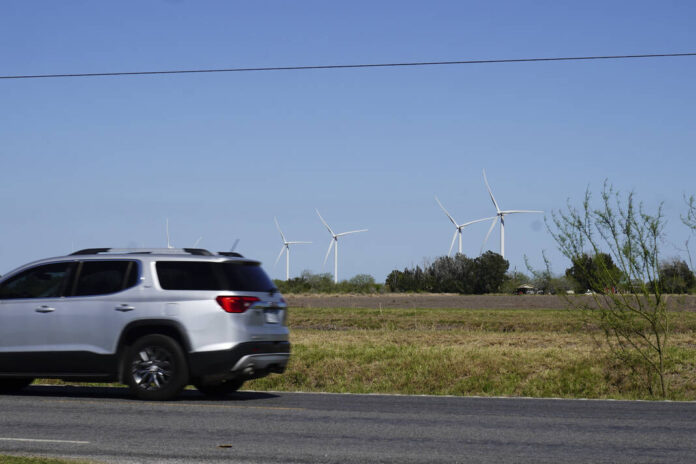HARLINGEN — For hundreds of years, the searing Santa Ana winds have been cursed as the “devil wind,” fanning fire along the Southern California coast.
Across the Great Lakes, northern gales carry the November Witch into autumn.
In Chicago, Lake Michigan’s icy Hawk howls through the Windy City’s canyons of skyscrapers, gusting up to 75 mph.
Through the ages, the wind has had many names.
But in the Rio Grande Valley, the locals have yet to christen the Gulf of Mexico’s ferocious spring winds, Tim Speece, a meteorologist with the National Weather Service in Brownsville, said.
“As far as I know, there’s no actual name for it,” he said. “But some folks around here call it the Valley Wind Machine.”
Last Monday, the Wind Machine cranked out a phenomenal fury, ushering spring with the strongest winds recorded here in recent history, Kirk Caceres, a meteorologist at the weather station, said.
“It’s the strongest that we can recall that wasn’t storm-related,” he said. “It was an extreme and unique event.”
As a Midwestern cold front spawned deadly tornadoes pummeling parts of Oklahoma, Texas and Louisiana, it drew hot Gulf winds that battered the Valley with sustained high gusts for about 24 hours, Caceres said.
In Harlingen, the winds reached speeds of 66 mph, Speece said.
“That was a pretty exceptional event,” he said. “Right here on the coastline were the strongest winds. They lightened up when you get past McAllen, which had 58 mph.”
Curses, blessings
Across the Valley, the Wind Machine belches like a hot hurricane, blamed for fanning wildfires and wreaking widespread damage.
But it’s also driving a growing wind farm industry that’s helping diversify Willacy County’s agricultural economy.
Spring blasts off
As winter wanes, the searing south winds usher springtime in the Valley, often packing sustained gusts rivaling fierce tropical storms.
“That’s how you know you’re coming out of the winter in the Valley — the Wind Machine cranks up,” said Speece, who’s been charting the wind’s speeds here for 27 years. “The only days we have stronger winds are when we have tropical cyclones, like a tropical storm or a hurricane.”
Now is the season the Wind Machine cranks out its fiercest gusts.
“March and April are basically the strongest winds of the year,” Speece said. “In the spring months, they’re probably relatively strong compared to the rest of the country.”
Fanning wildfires
For days, the Valley Wind Machine has led the National Weather Service to issue its Red Flag alerts across Deep South Texas, warning of the threat of wildfires amid the region’s drought.
“It’s been an ongoing issue, especially for the western counties because of the ongoing drought,” Speece said, referring to wildfires and control burns. “A good chunk of the Valley’s seeing dry weather. We have fires pretty regularly — sometimes they can be wildfires. We generally will have one or two every day. Usually, if it’s a wildfire, it’s accidental, especially with the ongoing drought.”
Smoky haze
Across Texas, the Wind Machine impacts air quality, pushing north as it draws smoky haze rising from agricultural fires in Mexico and Central America, Speece said.
“It can significantly reduce the air quality in Texas and a good chunk of the country,” he said. “That wind can bring smoke and haze to us and a good chunk of Texas.”
Catching the wind
In the Valley, the Wind Machine is churning big money.
Since 2010, the winds have led developers to the sprawling farms and ranchlands of Willacy County, where their towering turbines are transforming the landscape while pumping millions of dollars into rural school districts.
Now, Jeff Ferguson, senior vice president for development with Charlottesville, Va.-based Apex Clean Energy, is planning a wind farm stirring 67 turbines across the historic El Sauz cattle ranch.
A natural phenomenon rising out of land and water temperatures spawns the Gulf wind, he said.
“It’s kind of a unique wind resource,” he said. “It’s caused by the differential in temperatures between ocean water and surface temperature on land. That differential is greater in summer months at the same time customers use their air conditioners.”
‘Bankable’ winds
Today, about 1,000 wind turbines rise from seven wind farms across Willacy County’s swaths of farm and ranchlands, Agustin Lopez, the county’s chief appraiser, said.
For years, local businessman Joe Wetegrove has been working with developers from as far as London to catch the wind.
The Gulf wind packs the right ingredients to drive wind farms, he said.
“Different areas of the country have different types of winds,” he said. “We have coastal wind. Coastal wind blows most during the day — high energy use is during the day.”
Wetegrove calls the Valley wind’s speed “optimal.”
“You’re looking for a constant speed of wind,” he said. “If it’s constant — 8 to 12 mph — it goes all the time.”
For wind farming, the steady wind has become “bankable,” Wetegrove said.
“The Valley happens to have wind that’s fairly constant,” he said. “You need a lot of space for wind farms — and there’s a lot of space because of the farmland.”




